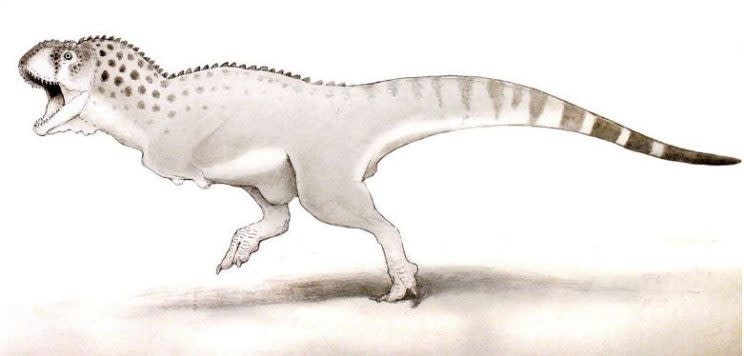Remains of one of the last ever dinosaurs found in Moroccan mine

Remains of the Chenanisaurus barbaricus were found in a Moroccan mine (University of Bath)
The remains of one of the last ever dinosaurs have been found in a phosphate mine in northern Morocco.
The Chenanisaurus barbaricus was one of the final dinosaurs to walk the earth before their extinction 66 million years ago – and the find is so rare that it has been compared to a lottery win.
The new species is described as an African relative of the North American T. rex.
Last year, Dr Nick Longrich from the University of Bath studied a rare piece of Chenanisaurus jaw bone, found in the mines at Sidi Chennane in the Oulad Abdoun Basin, Morocco.
In collaboration with colleagues in Morocco, France and Spain, he identified it as that of an abelisaur.
Abelisaur’s are described as two-legged predators, similar to tyrannosaurs but with smaller arms and shorter, blunter snouts.
The fact that the teeth were so worn is taken as a sign that, like the T. rex, the Chenanisaurus was a predator.
MORE: Buckingham Palace says ‘no cause for alarm’ after all staff called for unusual meeting
MORE: Do these satellite images prove North Korea is about to carry out another nuclear test?
Dr Longrich said: “This find was unusual because it’s a dinosaur from marine rocks – it’s a bit like hunting for fossil whales and finding a fossil lion.
“It’s an incredibly rare find – almost like winning the lottery. But the phosphate mines are so rich, it’s like buying a million lottery tickets, so we actually have a chance to find rare dinosaurs like this one.”
Dr Longrich added: ““We have virtually no dinosaur fossils from this time period in Morocco – it may even be the first dinosaur named from the end-Cretaceous in Africa. It’s also one of the last dinosaurs in Africa before the mass extinction that wiped out the dinosaurs.
“It’s an exciting find because it shows just how different the fauna was in the southern hemisphere at this time.”

 Yahoo News
Yahoo News 


